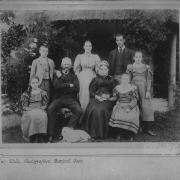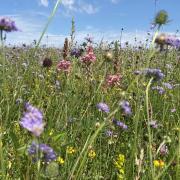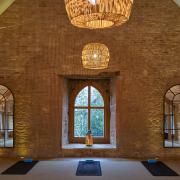To celebrate this year’s British Flowers Week (June 14-20), we caught up with Caroline White of Abbey Meadow Flowers. Caroline started the business after a previous career as a buildings’ surveyor and, since 2012, has been helping brides celebrate their special day with natural, English-grown bouquets. We asked her what it is like being a wedding florist based in glorious Gloucestershire
What made you want to become a wedding florist?
It began slowly. I completed evening classes in floristry purely for fun and then began to make bouquets for friends and family. The first wedding flowers I did were in 2012. I launched Abbey Meadow Flowers in 2014, starting with just four weddings that year.
How long have you been a wedding florist?
My course was in 2009 so building up the business was quite a slow burn and I was having children in and among. Now, I regularly undertake 30 plus weddings per year. I am a natural, seasonal florist and, through word of mouth recommendations, I also provide flowers for new homes, gift bouquets for a variety of purposes, farewell flowers for funerals and I love running workshops which mixes things up. When allowed, I do Christmas wreath, hen party, hand-tied bouquets and flower crowns’ workshops.

What’s your favourite part of the job?
On the growing side, I still feel sheer delight when seeds emerge from the soil. It never fails to amaze me. I started my flower patch at home in 2012 and I am happy to show people around so that they know where their flowers are grown.
On the floristry side, I get a real buzz out of being creative. Taking a bride’s idea and running with it to create fairy-tale settings, large and small. I love designing large-scale centrepieces – the floral hoops, flower bombs, whimsical archways. These can be incredible backdrops for weddings and family celebrations.
On the flip side, small-scale touches can mean so much too. A friend was married at a former cotton mill in Derbyshire. I sourced cotton ‘flowers’ for the buttonholes, which were a subtle touch but were quite the talking point!
Overall, I love that I am always learning and developing new skills. I am exploring more floristry techniques so as not to use floral foam. I have learnt business and IT skills and I am always, always learning more about growing flowers.
What are your top tips for people planning flowers for their event?
- I think flowers are an essential part of any special event – they feature in all the photos and are a key part, especially, of wedding-day memories
- Using in-season flowers and foliage helps to set your ‘date’ and they create the atmosphere for your guests to relax and enjoy the day
- It’s not just flowers – seasonal foliage, herbs, seed heads and blossom can all play a part in creating stunning, memorable and natural statement pieces
- Think about why you have chosen your venue, what style of wedding you want, which key features do you want to emphasise? And then work to a budget
- Remember many floral items can be repurposed throughout the day
- Flowers are a fabulous gift and can be given to friends and family after the event – they are a lovely way to say thank you
- Talk to your florist early in the planning! Often brides think they need to buy all the extra props but many florists have log slices, vases, candelabras etc. so this can save you money
- Make sure you explore British flowers – there is so much variety and scent – and this is a more environmental way of planning your event and adds to the sense of the event being carefully planned

Can you describe what happens in the run-up to a big day flower-wise?
A lot happens in a short space of time! I review the requirements and consider what flowers are going to be in season. I look over my flower patch to select key seasonal blooms – ranunculi, peonies, roses and dahlias – plus a variety of filler plants, for example, cornflowers, sweet peas, corncockle, lupin, delphinium and snapdragons.
For larger events, I will order some buckets of flowers from other local suppliers. I ensure these will be prepped two days’ prior to the event. This allows me to condition the flowers in a cool, dark place with lots of water, so they are super hydrated and will stay fresh as long as possible.
For a wedding, I prepare the bridal party flowers first, selecting the best blooms and foliage. I leave these to condition and will only create the bouquets and buttonholes on the afternoon before the wedding. This ensure freshness, reduces bruising and ensures the blooms are in tip-top condition.
READ MORE: How to grow a three-ton water lily.
Again, for large events, the table decorations and large installation pieces are created first. I often green up and only half-dress with flowers to gain a feel for the shape and style and then finalise arrangements, in situ, on the day of the event.
For larger weddings, I may have some gifted florists help me to create arrangements and install the full design. The team approach ensures we can complete the task on time. Larger tipi-style weddings with grand installations can dictate team of up to four people or more.
With your flower patch, can you describe what goes into setting up a cuttings’ patch and how the cycle works?
Lots of hard work! I started with just one bed, then extended it and then added two more. I use all areas of my garden and I never feel I have enough space.
The growing cycle is exactly that: it’s a cycle that never ends. I sow seeds in February and March and pot on and set out plants through April and May. I second sow in May for a longer season of flowers. In July and August, it is time to sow biennials and then in September and October, I sow hardy annuals to over winter. In October and November, I plant bulbs for spring and, in spring, I plant bulbs for autumn flowers.

There is prepping the soil, creating compost heaps, feeding and watering, bug control and of course defending your precious blooms from deer, rabbits and other nibblers.
If you are starting out, start small. Work out which flowers you would love to have and choose hardy annuals initially as they are ‘cut and come again flowers’. They offer a lot of bang for your buck.
When you are thinking about the early and late parts of the growing season, investing in perennials can help.
Having sufficient foliage is often the hardest part of having a cuttings’ patch as shrubs take years to grow large enough to withstand constant snipping.
Flower growing networks are very good to join as they will help support you and you can glean information. I am a member of Flowers From the Farm.
Overall, it is a friendly business and I have never looked back changing career. British flowers are fabulous in every way and I feel strongly that they must be shared and enjoyed.
SUBSCRIBE: To Cotswold Life for oodles of home and garden inspiration.
Do you prefer winter, spring, summer or autumn weddings?
I enjoy dressing summer and autumn weddings the most. The summer has such a broad range of flowers and herbs offering a huge array of colour, texture and scent. The autumn weddings enjoy deep colours and fabulous seed heads too for added drama.

What’s the best part of working from the Slad Valley?
Could the setting be any better? I am so spoiled. I have valley views from my workshop with cattle and sheep on either side and a stunning view of Swift’s Hill. My floristry has definitely been influenced by living here – watching the seasons change, blossom emerge, buds and tree ferns unfurl. I love the textures of nature – moss and wood bark often feature in my designs, especially for Winter weddings. Then looking for the first signs of Spring with snowdrops, crocuses and forsythia’s golden leaves.
Could you say how pleased you are that weddings are starting to come back now lockdown is easing up again?
I am delighted to be creating wedding flowers again. The first few weddings will only be small – up to 15 people – but it is such a joy to be part of someone’s big day. The bridal bouquet is always special. They are created with love and care to show the bride’s personality and style.
The second half of this year is full of weddings that have been postponed – often several times – so I know they will be very special and full of even more love and joy!
Abbey Meadow Flowers, abbeymeadowflowers.co.uk
British Flowers Week
To get involved with this year’s British Flowers Week campaign, organisers are encouraging businesses and the public to decorate their windows with British flowers in their home or places of work; preferably where passers-by can enjoy them from June 14-20. Whether it’s with a single stem, a bouquet made from garden flowers or a spectacular display, a decorated window with show support for the British flower industry this June.
To get involved, create a window with British flowers, foliage or plants, from the garden, a local grower, florist or wholesaler. Once you’ve created your design, take a picture of your British Flowers Week window, share it on social media using #BritishFlowersWeek and tag @MarketFlowers to show support for British businesses and go in the draw to win fantastic prizes.




















![Latenightpass with Gina Andrews [left] wins the Cross Country Chase at Cheltenham, December 15, 2023. Photo: Steve Davies/SDphotos.co.uk](/resources/images/128x89/1x/17621852.jpg)
![Latenightpass with Gina Andrews [left] wins the Cross Country Chase at Cheltenham, December 15, 2023. Photo: Steve Davies/SDphotos.co.uk](/resources/images/180x180/1x/17621852.jpg)






